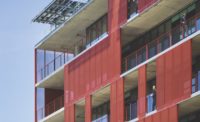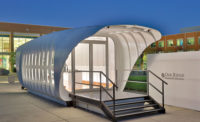Fresh Face, New Spine
Skidmore, Owings & Merrill (SOM) relied on a similar approach for its makeover of a fortresslike office building in San Francisco's South of Market neighborhood, at 680 Folsom Street. The just-completed project, designed for developer TMG Partners, had the aim of transforming the property, vacant since 2007, into desirable office space. The comprehensive renovation included replacement of the 1960s structure's seemingly impenetrable precast-concrete facade panels with a high-performance curtain wall, largely glass. “The goal was to make it more open and inviting and have the activity inside energize the street,” says Leo Chow, an SOM director.
The project also entailed increasing the leasable area by almost a third, to 500,000 square feet, with the addition of small projections on each facade and two new floors on top of the original 12. “The building was a simple, dumb box,” says Chow. “We wanted to articulate it as a series of masses.”
The replacement cladding consists of one-story-tall, 6-foot-wide units that include 10-foot-high insulated vision lites. These afford views of the city's financial core and San Francisco Bay and let daylight deep into the interior. Vertical aluminum fins on the building's northwest-facing facade shield the glazing from the setting sun.
Although attaching a new facade to an existing building is often complicated by elevated code requirements for wind loads and other forces, 680 Folsom's new skin is attached to the structure via the building's original anchors. Their strength proved sufficient, since they had been designed to support the hefty precast panels. “The robust existing slab anchors greatly simplified the retrofit,” says Mic Patterson, director of strategic development at Enclos, the project's facade contractor. “We just had to weld our connector to the existing steel embeds, and we were ready to go.”
The building's steel moment frame did, however, require a seismic retrofit because of the added floors. Early on, the design team considered adding diagonal bracing. Ultimately they rejected such a system, since the braces would occupy valuable floor space and obstruct views through the new curtain wall. Instead, the project's structural engineer, Tipping Mar, devised a novel solution that involved reconfiguring the building core to create a pivoting spine. During a temblor, this base-isolated, reinforced-concrete element should redistribute seismic deformations throughout the structure and prevent the phenomenon of “weak story” at the base, where perimeter columns have vertical spans of 35 feet instead of 15 feet, the building's typical floor-to-floor height. Weak story exists, says Steve Tipping, Tipping Mar principal, where a story's lateral strength is less than 80 percent of the one above it. The new core at 680 Folsom prevents this condition by “forcing the floors to hang together and act as one unit,” he says.
In addition to ensuring that the building's structural integrity is maintained, the retrofit strategy should also minimize damage to nonstructural components, including the building skin. The pivoting spine will limit inter-story drift (the horizontal movement of one level of a building relative to the one above it), making extensive repairs to the curtain wall unnecessary after a design basis earthquake—a quake for whose magnitude the building is designed, in this case one with only a 10 percent chance of being exceeded in 50 years.
Chow says that the importance of protecting the investment in a building's skin should not be underestimated. “To an owner, that's where the value is,” he says, adding that at 680 Folsom, “the facade projects a sense of quality and clean modernism.” This image apparently has market appeal: last summer, while construction was still under way, TMG sold the tower to Boston Properties after leasing almost all of its office space to Macys.com and Riverbed Technology. The companies are expected to move in early next year.
Less-Invasive Surgery
At 680 Folsom and Jorgensen Lab, new facades are just one aspect of those buildings' almost complete reinvention. But installation of a new skin can also be part of less radical transformations, used to address performance problems or to subtly tweak a building's image. Such was the case for a 33-story apartment building with a stepped profile on Manhattan's Upper East Side, designed by Emery Roth & Sons in 1962. The 608-unit tower at 215 East 68th Street was one of the first to use two relatively new, and not yet well-understood technologies: it had a lightweight concrete structure and a cavity-wall facade of one wythe of white-glazed brick with a backup wall of concrete masonry. Over the years, the concrete structure was slowly shrinking. The condition, known as creep, put pressure on the brick, which had been laid without relieving angles. As a result, it bowed and spalled, and water found its way into the interior.
In an attempt to address the problem, the property's manager, Rudin Management, had periodically replaced large sections of brick—a practice that gave the tower a patchwork appearance. For a more lasting solution, Rudin turned to the team of FXFOWLE Architects and a facade specialist, Forst Consulting and Architecture.
The two firms explored replacing the old skin, which covered about 350,000 square feet, with a new brick cavity wall that would be better detailed than the original. But they soon realized that new reinforcement for the inner block wall could serve double duty, functioning also as an armature for terra-cotta rainscreen cladding. They reasoned that a rainscreen system—a two-stage wall where an outer, open-jointed layer serves as the primary barrier for rain, snow, and hail but is not weather-tight—would offer a number of advantages over a brick cavity wall. Because there is an inner weatherproof layer that incorporates insulation as well as a barrier membrane and is separated from the outer skin by an airspace, the exterior cladding is essentially back-ventilated, improving drying capacity, says Ralph Forst, Forst Consulting principal. Another chief benefit is weight—terra-cotta tiles are significantly lighter than brick, which would mean less stress on the building's structure.
The system that the project team developed consists of tiles typically about 1¼ inch thick, 9½ inches tall, and 36 inches long, supported by an extruded aluminum armature. Behind the tiles is a 4½-inch airspace and then 3 inches of semi-rigid insulation over a new barrier membrane covering the existing block wall. Designers maintained white as the facade's dominant color but added banding of gray and black between the building's punched windows. The scheme retains some of the character of the original brick, “but it is richer and more pleasing to look at,” says Bruce Fowle, FXFOWLE founding principal.
Although construction is still going on at the building's base, which will be clad in stone, the terra-cotta work was completed earlier this year. Installation on an existing, fully occupied structure presented several complications. One was the project sequence, which needed to be orchestrated so that it could be performed top-down. If contractors had performed the work bottom-up, the usual method for new construction, they risked damaging already-in-place terra-cotta tiles while demolishing the old brick face, says Bud Streff, director of sales for NBK, the tiles' manufacturer.
The designers and the client are counting on the rainscreen's ease of maintenance. They expect the tiles to be durable, but if some do break or the barrier membrane requires inspection to locate leaks, removal can easily be accomplished without the messy grinding or sawing required for the repair of brick, says Forst.
No leaking or breakage has occurred. However, it's still too early to know if the terra-cotta will be as easy to maintain as its project team hopes. But there is a larger question regarding 215 East 68th Street, and for any building that has been revamped with a new skin: will their new facades seem as fresh decades from now as they do today? It would be interesting to return to the Upper East Side, to the South of Market neighborhood, and to Caltech in twenty years to see if any of the buildings have exchanged their replacement skins.
PeopleJorgensen Laboratory
Formal name of building:
Location:
Completion Date:
Gross square footage:
Total construction cost:
Client:
Architect's firm:
Personnel in architect's firm who should receive special credit:
Engineers:
Structural: Saiful Bouquet
Civil: VCA Engineers
Consultants:
Landscape Architect: The Office of James Burnett
Technology & Acoustics: Waveguide Consulting, Inc.
FF&E: Neiman Studio
General contractor:
Photographer: 680 Folsom Street
Formal name of building:
Location:
Completion Date:
Gross square footage:
Client:
Architect's firm:
Personnel in architect's firm who should receive special credit:
Consultant:
General contractor:
Photographers: © Skidmore, Owings & Merrill LLP 2013 Tel: 415.352.6817 215 East 68th Street
Formal name of building:
Completion Date:
Gross square footage:
Client:
Architects:
Forst Consulting and Architecture, PLLC
Personnel in architect's firm who should receive special credit:
FORST
Architect of record, if applicable:
Engineer(s):
Consultant:
General contractors:
Photographers:
Ashley Streff |
ProductsJorgensen Laboratory
Structural system
Metal/glass curtain wall:
Glazing:
Windows:
Shading devices: 680 Folsom Street
Structural system
Exterior cladding
Manufacturers 215 East 68th Street
Structural system
Exterior cladding |























Post a comment to this article
Report Abusive Comment